A strong link profile is crucial for achieving high rankings in search engines. However, many SEO professionals and website owners get confused by fundamental concepts: what matters more, the number of backlinks or the variety of referring domains? And what exactly sets them apart?
At first glance, the difference might seem minor. In reality, though, it’s this distinction that determines how effectively your website climbs in organic search results.
A small detail? Only at first glance.
Worth understanding? Absolutely.
Grasping the difference between referring domains and backlinks enables you to build a strategy that strengthens your site’s credibility with search engines and unlocks new growth opportunities.
In this article, we’ll dive into:
- What are referring domains and backlinks?
- How each of these metrics impacts SEO.
- How to analyze and enhance your link profile using tools like Ahrefs, Semrush, and others;
- Strategies to gain more referring domains and backlinks without compromising the quality of your link profile.
If you’re looking to build an SEO strategy with purpose and measurable results, this guide is a great starting point.
What Are Backlinks?
Backlinks, also known as inbound links, are hyperlinks from other websites that direct users to your website. They play a critical role in search engine optimization (SEO), as search engines use them as a key indicator of a webpage’s trustworthiness and authority.
Consider an example of a backlink from editorial.link.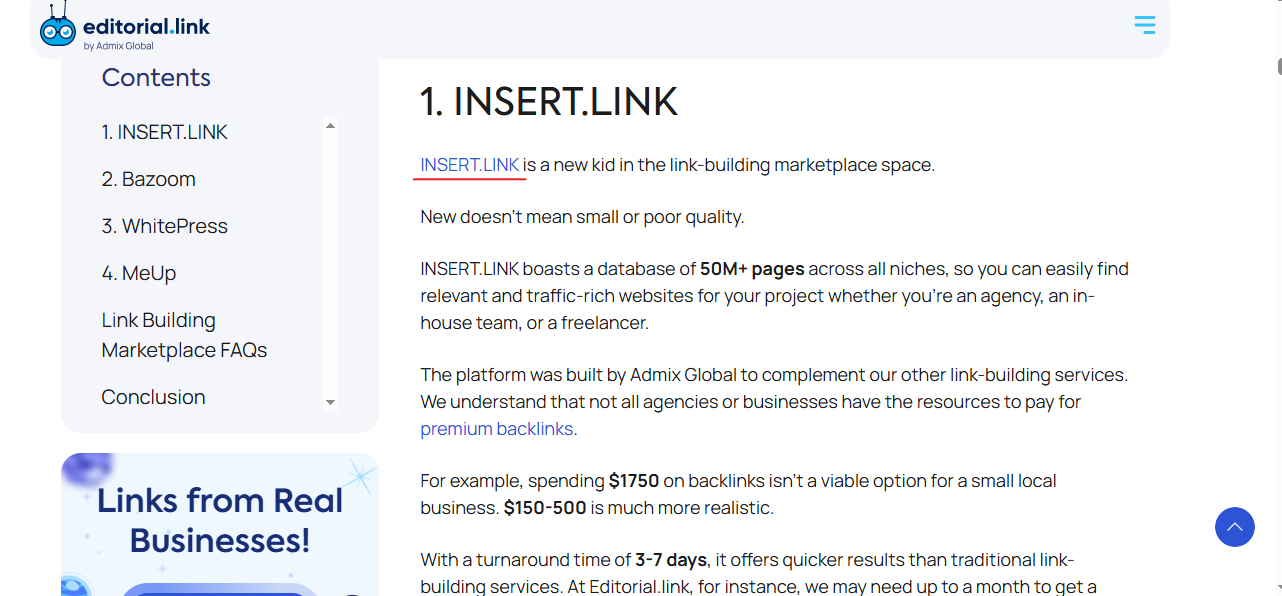
As the example shows, a backlink is more than just a technical element. It acts as a vote of confidence from one website to another. But why do search engines value these signals so highly, and how exactly do they impact SEO?
To understand this, let’s explore how backlinks work and their role in website promotion.
How Backlinks Work
Imagine this: if a reputable website mentions your site in an article, wouldn’t you, as a user, view that site as more credible?
Search engines operate similarly. Backlinks serve several key functions:
First, they pass what’s known as “link equity” (or link juice), which can boost your page’s ranking in search results.
When an authoritative site links to your page, search engines see it as a “vote of trust,” potentially improving your site’s visibility.
Second, backlinks help search engine crawlers discover new pages. When other sites link to your content, search engines are more likely to visit your site frequently, indexing and updating your information.
Third, links from authoritative and relevant sources signal to search engines that your content is valuable and helpful to users.
This builds trust in your site as a reliable source of information. The more reputable websites link to you, the greater the chance you’ll stand out.
Finally, backlinks can drive organic traffic. When a popular or high-ranking site links to you, its audience may click through to your site.
Consider how often you follow links in engaging blog posts or news articles – this is a direct path to attracting new visitors.
Note: Not all backlinks are equally valuable. For instance, links from low-quality or spammy sites may not only fail to help, but could harm your SEO.
Types of Backlinks
- DoFollow Links: These are standard backlinks that pass link equity, and search engines consider them when ranking pages.
- NoFollow Links: These links don’t pass link equity and aren’t used by search engines to assess page authority. However, they can still drive traffic and may indirectly benefit SEO.
How to Build Quality Backlinks: Proven Strategies
Creating a strong link profile starts with a thoughtful strategy. Waiting passively for others to link to your site is a losing approach. To consistently earn high-quality backlinks, you need to take deliberate action.
Here are five proven strategies to steadily grow your link profile:
- Create Link-Worthy Content
High-quality content is the cornerstone of successful link-building. The more valuable your content is to your target audience, the more likely other sites will naturally link to it.
What attracts links?
- Original research or surveys with fresh data
- In-depth guides and expert articles
- Infographics that simplify complex topics
- Case studies or success stories based on real experiences
- Reclaim Broken Links
Broken links are missed opportunities. You can turn them into valuable backlinks for your site.
- Identify pages with broken links using tools like Ahrefs or Moz.
- Create high-quality content on the same topic.
- Reach out to site owners and offer your content as a replacement for the broken link.
- Leverage Industry Directories and Resource Pages
Strengthen your link profile by getting listed on recommendation pages or directories. Focus on reputable, authoritative platforms.
Where to find opportunities:
- Professional associations or organizations
- Partner or client websites
- Build Partnerships
Collaborate with companies, bloggers, or communities in your niche that aren’t direct competitors.
Effective ways to partner:
- Co-create content, research, or webinars
- Speak at conferences or industry events
- Use Digital PR
Working with media and journalists can quickly boost your link profile and site authority.
What works well:
- Pitching unique stories or compelling case studies
- Providing expert commentary for news outlets
- Sharing research results that appeal to a broad audience
How Search Engines Evaluate Backlinks
When it comes to SEO, backlinks play a crucial role.
Each link pointing to your website acts as a recommendation or vote of confidence from another source. But how exactly do search engines evaluate these links, and what do they focus on?
Evaluating backlinks is a multifaceted process that involves several key factors determining the value of these links for your website.
- Source Authority: How significant is the website linking to you?
If a highly authoritative resource links to your site, it signals to search engines that your site is worthy of attention. For example, if a central news portal or a popular blog links to your article, it boosts trust in your resource. However, it’s essential to recognize that authority doesn’t always depend on the number of links from a specific site, but instead on the overall authority of the domain.
Search! engines consider Domain Authority (DA), a metric that reflects a site’s reputation. The higher this metric, the more valuable the links from that site will be.
Links from authoritative domains, such as major news agencies, educational institutions, or industry leaders, carry far more value than links from less reputable or questionable sources. - Content Relevance: Why does topical connection matter?
Links from websites closely related to your content hold significantly greater value. This is particularly important in the context of niche topics. For instance, if you manage a health-focused site, links from medical websites or healthy lifestyle blogs will be more valuable than links from, say, fashion or automotive sites.
Search engines rely on the topical connection between pages to determine how relevant the linking site is to yours.
When search engines see that links come from resources covering similar topics, it adds contextual value to your pages. This way, they can assess your site as more authoritative and suitable for a specific field of knowledge. - Anchor Text: How proper use of link text improves SEO
Anchor text is the clickable text that users click to follow a link. For search engines, this text serves as an essential indicator of what the linked page is about.
The anchor should be informative, precise, and reflect keywords relevant to the content of the target page.
For example, if a link to your page uses the anchor text “buy the best running shoes,” the search engine will expect that the page contains at least information about running shoes. If the page’s content matches the query, search engines will consider this link more relevant and valuable for users.
Using varied anchor texts is also important to avoid penalties from search engines. Over-optimized anchors, such as repeatedly using exact keywords, can raise suspicions with search engines that the site is attempting to manipulate search results. - Number of Sources: Why is it important to have links from different sites?
When many different resources link to your site, it indicates that your content is recognized across various platforms. However, links must come from different referring domains, not just one or two.
A diverse range of sources enhances the naturalness of your link profile. The more unique websites link to your page, the more search engines perceive your site as significant and valuable.
However, simply having numerous links isn’t always a positive sign. The quality and diversity of links are what truly matter. If only low-quality or suspicious resources link to your site, it can negatively impact your SEO. - Content Freshness: Why does link relevance matter?
Search engines also value fresh and up-to-date content. Links from websites that are regularly updated with new news or materials are considered more valuable than links from outdated sources.
If the site linking to you provides current information, it highlights that your content meets modern demands and audience needs.
Links from news sites or blogs that publish fresh articles often help boost rankings in search results. This is because search engines aim to provide users with the most current and relevant information. If your site is linked in the context of recent events or trending topics, it makes your resource more attractive to search engines. - Quality of Your Site’s Content: The foundation of all links
Finally, don’t forget that the quality of your content plays a crucial role in determining the types of links other sites will place on yours. If your site doesn’t provide valuable information or solve user problems, links, even from highly authoritative sites, will be perceived as less significant.
Applicable content naturally attracts attention and encourages link placements. The more valuable and informative your site is, the more likely other resources will link to it, which, in turn, improves your position in search results.
How do search engines use these factors?
Search engines use all these elements together to assess the value of the backlinks to your site accurately.
Links from authoritative sources, relevant to your content, with informative anchor text and tied to current topics, all contribute to improving SEO. Moreover, a diverse range of sources and regular content updates help build trust in your resource, enabling it to achieve higher positions in search results.
Understanding Referring Domains

For beginner SEO specialists, it’s essential to understand what are referring domains and how they impact SEO.
A referring (or linking) domain is a unique domain that links to your website. Referring domains gain significance when building a high-quality link profile. In link-building and SEO, this term is crucial as it reflects the diversity of sources linking to your content.
It’s essential to recognize that a single website can generate multiple backlinks to your site, but these will be counted as only one referring domain. For example, if multiple pages from one site link to your resource, search engines will still consider it a single referring domain.
Each referring domain can contain numerous backlinks, but for SEO, the number of unique domains matters most. This metric indicates the diversity of your link profile: the broader it is, the higher your site’s authority in the eyes of search engines.
The Impact of Quality Referring Domains
Not all links are equally valuable. Links from authoritative domains, such as major news portals, universities, or official organizations, hold exceptional value.
Such links not only strengthen your SEO rankings but also establish your site as a reliable source of information, which, over time, leads to increased traffic, greater user engagement, and business growth.
The wider the range of websites mentioning your resource, the better your SEO results. The diversity of sources and the authority of referring domains directly influence your site’s position in search results.
To strengthen your link profile, it’s crucial not only to increase the total number of links but also to focus on attracting new, high-quality referring domains. These play a pivotal role in an effective link-building strategy.
What Is a Referring Domain, and How Does It Differ from a Backlink?
To better understand the importance of referring domains, it’s essential to distinguish between two key concepts: referring domains and backlinks.
A backlink is any hyperlink pointing to your site from another webpage. You can have multiple backlinks from a single source.
A referring domain, on the other hand, is the website itself that links to your resource, passing along a portion of its authority. Such a link is called a backlink, and the domain it comes from is the referring domain. Even if a single site creates dozens of links to different pages on your site, it will still count as just one referring domain.
For example, if five pages from example.com link to your site, this will still be counted as one referring domain, but you’ll have five backlinks.
This is why the number of referring domains is considered a more important metric than the total number of backlinks. It reflects the proper level of your content’s popularity across different websites, rather than just the number of link placements.
Why Referring Domains Matter for SEO

For search engines, it’s not just the number of backlinks that counts, but how diverse the sources linking to your site are. This is where referring domains come into play: their number helps algorithms gauge how widely recognized and valued your content is.
The more unique domains link to your site, the stronger the signal to Google and other search engines about your reliability and authority.
This isn’t just a collection of links – it’s the digital equivalent of endorsements from a variety of sources, reaching a broad audience.
How Does This Work in Practice?
- Diverse Link Profile.
When several unique domains link to your site, search engines interpret this as a sign of authority. It’s not just a bunch of links; it’s a network supporting your site from different corners of the internet.
Links from various referring domains demonstrate that your content is engaging and valued not only by you but also by external sources. It’s as if your site has gained popularity across diverse groups, not just within a single circle. - More Referring Domains, Higher Trust.
The more unique sources link to your site, the more trustworthy it appears to search engines. This signals that your content holds significant value for different user groups.
Search engines favor sites that are perceived as authoritative and applicable across multiple platforms and domains. Such a site will rank higher in search results compared to one linked by only a few limited sources. - Reducing SEO Risks.
If your site receives links from diverse, unique sources, it helps avoid scenarios where search engines question the quality of your link profile. When most links come from a single domain, it can raise red flags with search algorithms. However, links from various referring domains signal to search engines that the process is organic. - Resilience to Algorithm Changes.
Search algorithms are constantly evolving, and relying on links from just one domain can become a vulnerability if algorithms shift.
In contrast, a diverse set of referring domains creates a more stable position, as search engines view such sites as more reliable and less affected by algorithmic fluctuations. - Boosting Visibility and Driving Traffic.
A multitude of unique referring domains helps increase your site’s visibility in search results, which, in turn, drives more traffic to your site. The more authoritative sources link to your content, the higher the likelihood that search engines will rank your site higher in the results, leading to a greater influx of new users.
How Many Referring Domains Are Needed for Success?
No fixed number guarantees success. The more referring domains link to your site, the better your chances of improving your SEO position.
However, quality matters more than quantity!
For example, if dozens of major news outlets or popular blogs link to your site, this will carry far more weight with search engines than thousands of links from small or low-authority sources.
Backlinks vs. Referring Domains: A Comparison
When it comes to search engine optimization, understanding the difference between backlinks and referring domains is crucial for improving your site’s visibility in search engines. These two concepts may seem similar, but they play distinct roles in link-building strategies and can have a significant impact on your SEO results.
Let’s explore how backlinks differ from referring domains.
| Criterion | Backlinks | Referring Domains |
|---|---|---|
| Definition | Hyperlinks to your site are placed on external webpages | Unique domains (websites) that provide backlinks to your site |
| Unit of Measurement | Each individual link | Each unique domain |
| Display in SEO Tools | Shows the total number of links | Shows the total number of unique domains |
| Impact on SEO | Influences the weight of the specific page being linked to | Boosts the overall authority and trust in your site |
| Value | May have lower value if multiple links come from a single source | Higher value as the number of unique sources grows |
| Example | 5 links from one article = 5 backlinks | 5 links from one article = 1 referring domain |
| Quality vs. Quantity | The quality of links matters more than the quantity | Quantity matters if sources are authoritative and diverse |
| Risk of Over-Optimization | High – too many links from one domain may be seen as manipulation | Low – if links come from varied domains |
| Indicator of Naturalness | Many links from one source may appear unnatural | More domains = a more natural link profile |
| Difficulty of Acquisition | Often easier, especially through crowd marketing | More challenging, requiring diversity and a broader strategy |
| Use in Link-Building | Often a temporary tactic (e.g., forums, comments) | A priority for strategic link-building |
| Analysis in Ahrefs/Semrush | Displayed as the total number of links | Displayed as the number of domains, which is often more critical for assessing link profile quality |
| Impact on DR/DA | Minimal impact from repeated links | Significant – more referring domains can directly boost Domain Rating |
| Tactics for Growth | Can be scaled through the same platforms | Requires new sites, guest posts, and collaborations |
| Result Stability | May weaken if links are removed | More stable – losing one link isn’t critical if the domain remains |
| Crawl Updates | Indexed faster but less stably | Slower indexing but provides a more consistent SEO contribution |
Why Understanding the Difference Matters?
A clear understanding of the distinction between these two metrics enables you to build a more precise and effective SEO strategy.
- Backlinks = Quantity
Backlinks indicate the number of times a hyperlink points to your site. This is important, but doesn’t always reflect the quality of your link profile. For example, 10 links from a single site count as 10 backlinks but only one referring domain. - Referring Domains = Diversity
This metric reflects the number of unique websites linking to your content. The more referring domains you have, the better your chances of SEO success – search algorithms particularly value the diversity of sources.
How to Work with Backlinks and Referring Domains?
- Build Diversity
Focus on increasing not just the number of links but the number of unique sources. - Prioritize Quality
Links from authoritative websites are SEO gold. Aim to secure placements on trusted and popular platforms. - Conduct Regular Analysis
Monitor the dynamics of backlinks and referring domains to identify growth opportunities and address areas for improvement.
How to Analyze Backlinks and Referring Domains

Analyzing backlinks and referring domains is a critical aspect of search engine optimization (SEO). By analyzing Ahrefs referring domains, you can see which sites link to you, their level of authority, and even track the growth of new links.
Understanding this process will not only improve your site’s visibility in search engines but also attract a more targeted audience. Below, we’ll dive into how to analyze backlinks using Ahrefs, as well as other alternative platforms like Semrush, Moz, and Majestic.
How to Check Backlinks and Referring Domains with Ahrefs
Analyzing Backlinks
- Enter the Site URL: Input your website’s URL or a competitor’s into the search bar and click “Search.” Ahrefs will provide an overview of various metrics, such as the number of backlinks, referring domains, and traffic.
- Backlinks Overview: Navigate to the “Backlinks” section. Here, you’ll see a list of all links pointing to the specified site. You can view the source of the links, the anchor texts used, and the Domain Rating (DR) of the linking sites.
- Filtering and Sorting: Ahrefs allows you to filter data by various criteria. You can sort links by type (dofollow, nofollow), status (live, broken), and other parameters, enabling you to focus on the most valuable links.
- Anchor Text Analysis: In the “Anchors” section, you can review the anchor texts of links pointing to your site. This is crucial for understanding how other resources perceive your site and identifying opportunities to improve SEO.
Evaluating Referring Domains
Now that you’ve explored backlinks, let’s move on to analyzing referring domains.
- Navigate to “Referring Domains”: In this Ahrefs section, you can see how many unique domains link to your site. This metric reflects the diversity of your link profile.
- Assess Referring Domain Quality: Pay attention to metrics like Domain Rating (DR) and the number of pages linking to the domain. This helps you identify which domains are more authoritative and can bring greater value to your site.
- Identify Opportunities: Analyze domains linking to your competitors but not to you. This can uncover new opportunities for link placements and strengthen your link profile.
Other Tools for Analysis
Here’s how to navigate Semrush, Moz, and Majestic to analyze backlinks and referring domains:
- Semrush
Steps for Analysis:
- Log in to Semrush.
- From the menu, select “SEO” → “Backlink Analytics.”
- Enter the site’s domain and press Enter.
- You’ll arrive at a dashboard displaying key metrics:
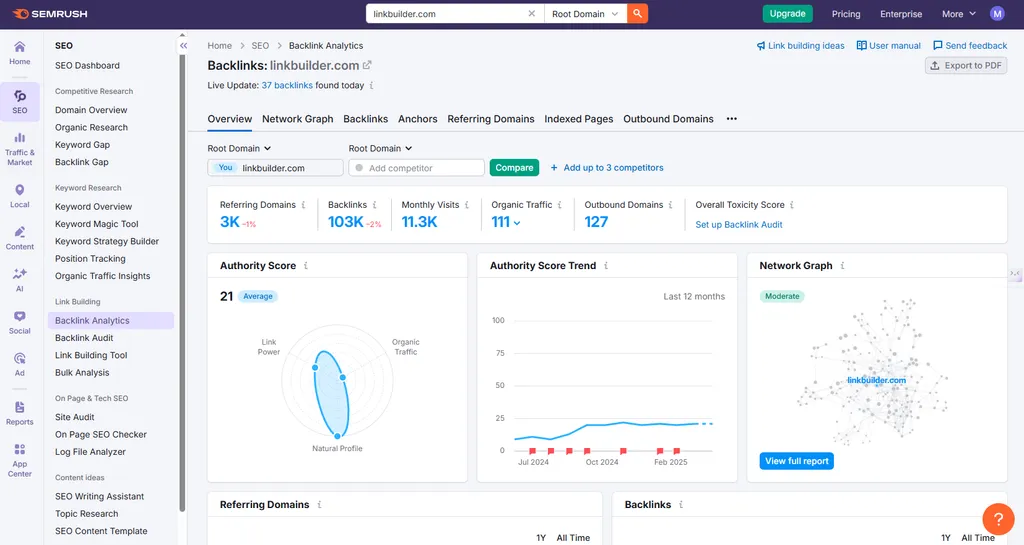
- Backlinks: The total number of backlinks.
- Referring Domains: The number of unique domains.
- Authority Score: The site’s authority level.
- Top Anchors: The list of anchor texts.
- Go to the “Backlinks” tab for a detailed view of all links.
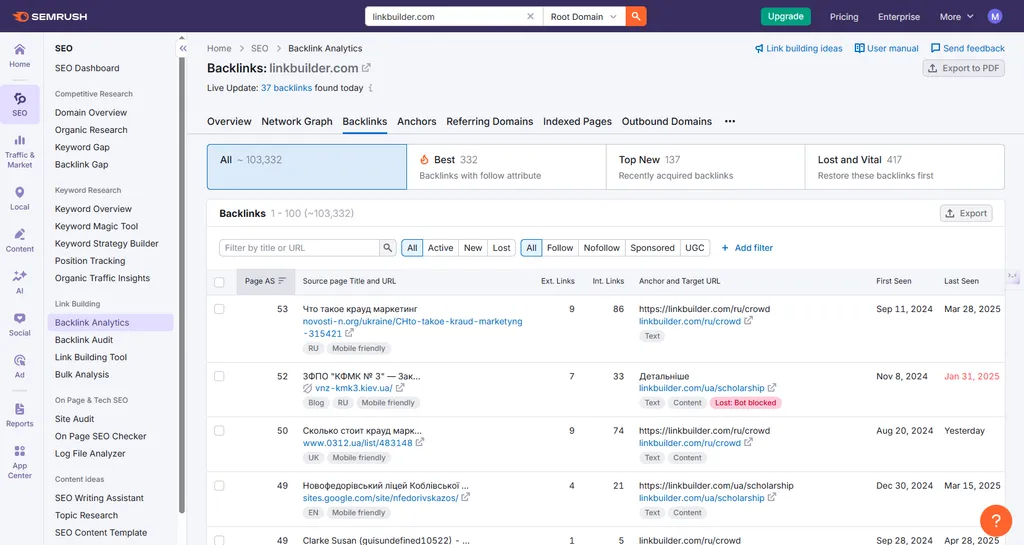
- Navigate to the “Referring Domains” tab to examine each source domain, its rating, and the number of links it provides.
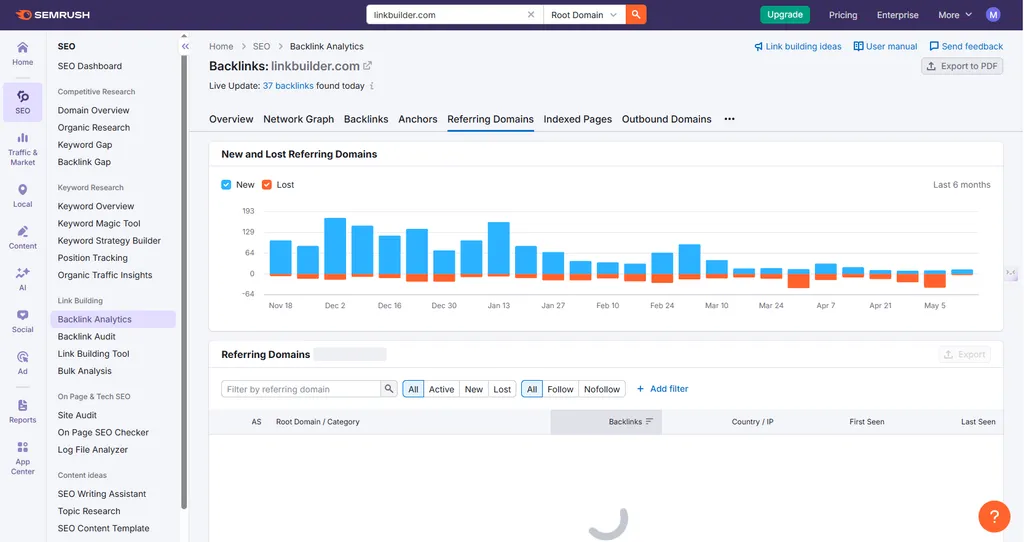
Tip: You can filter by link type (dofollow/nofollow), regions, TLDs, and other parameters.
- Moz (Link Explorer)
Steps for Analysis:
- Log in to Moz.
- Enter the domain in the search bar and click “Analyze.”

- You’ll see:
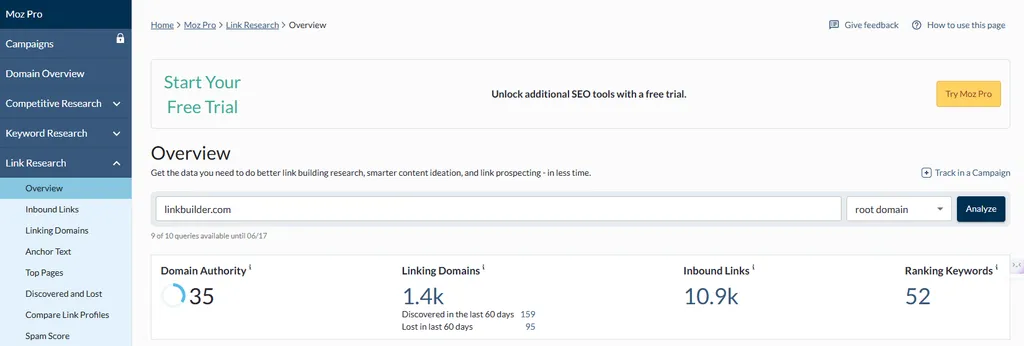
- Inbound Links: The total number of backlinks.
- Linking Domains: The number of unique domains.
- Ranking Keywords: The number of keywords the site ranks for.
- Domain Authority: Predicts the ranking potential of the root domain compared to other domains.
- For detailed analysis, click:
- Inbound Links: A list of all backlinks with details (anchor text, link type, referring page).
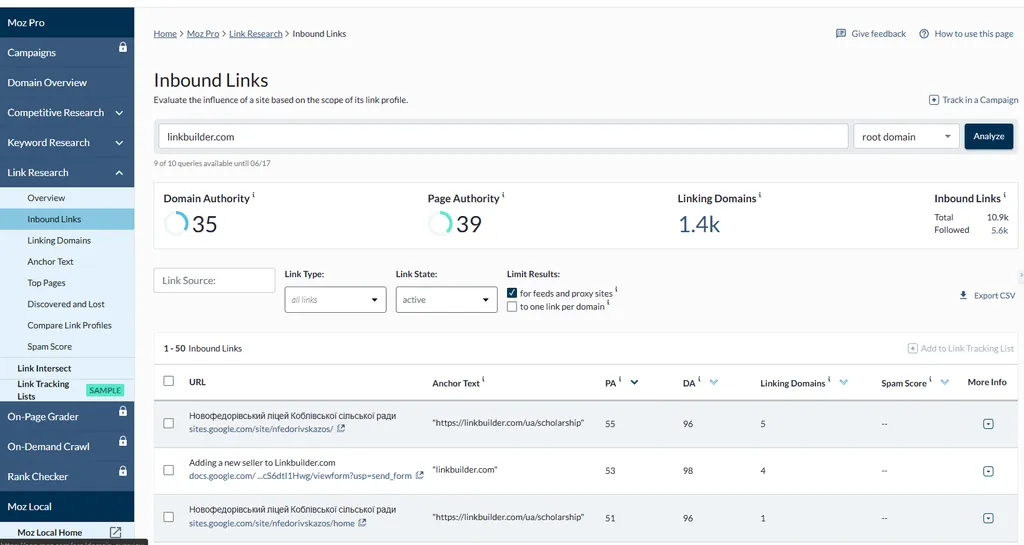
- Linking Domains: All unique domains providing links, along with their Domain Authority (DA).
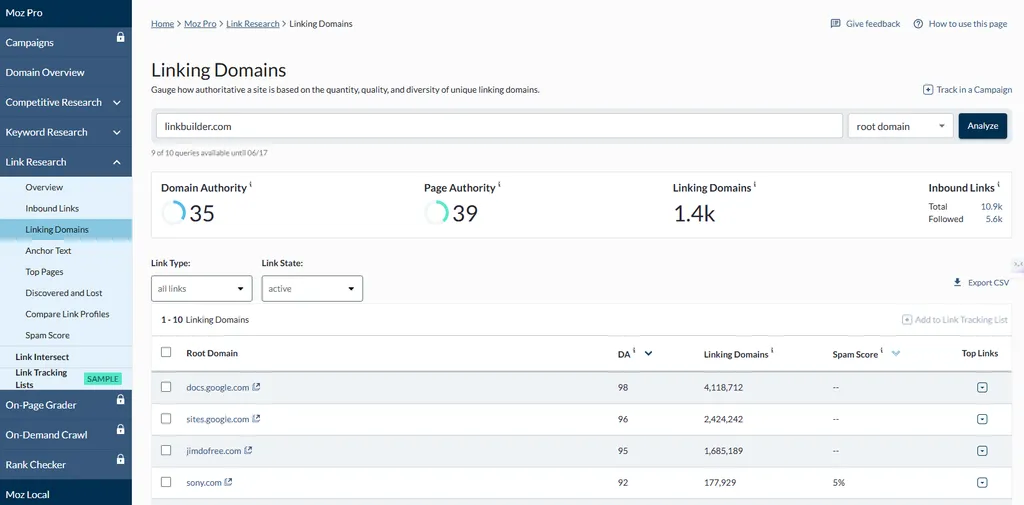
- Inbound Links: A list of all backlinks with details (anchor text, link type, referring page).
Note: Moz often restricts data in the free version. For full access, consider using the PRO version or a trial period.
- Majestic
Steps for Analysis:
- Log in to Majestic and enter the domain in the “Site Explorer” field.
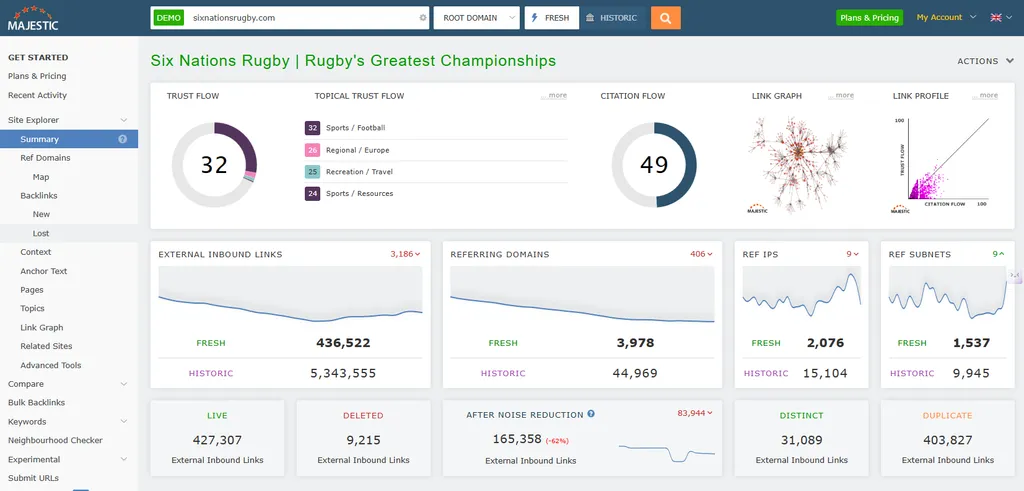
- The main dashboard will display:
- External Inbound Links: The total number of links.
- Referring Domains: The number of unique domains.
- Trust Flow / Citation Flow: Metrics indicating quality and popularity.
- Navigate to the following tabs:
- Ref Domains: A complete list of referring domains, showing the number of links from each and their Trust Flow (a trust indicator).
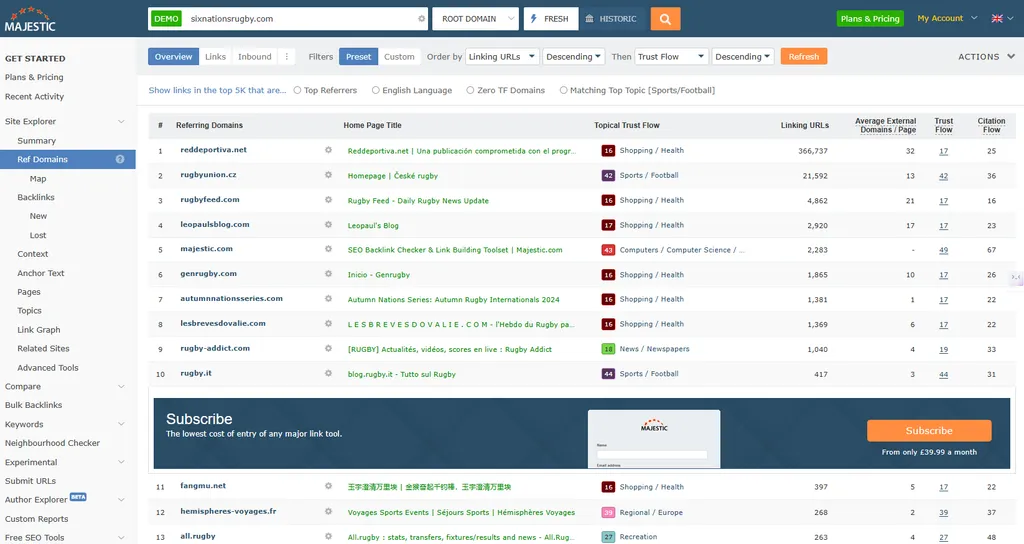
- Backlinks: A list of all backlinks with anchor texts and their status (dofollow/nofollow).
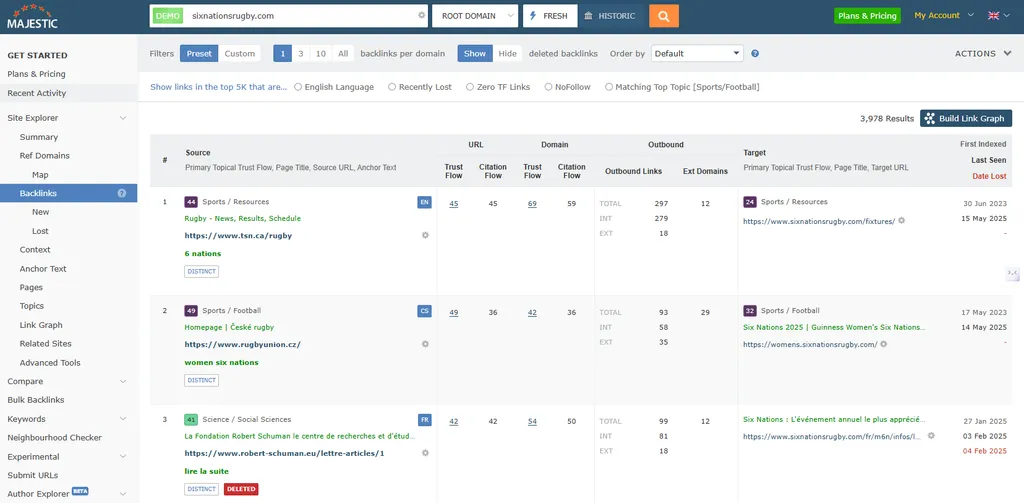
- Ref Domains: A complete list of referring domains, showing the number of links from each and their Trust Flow (a trust indicator).
In Majestic, you can switch between the Fresh Index (data from the last 90 days) and the Historic Index (the whole history of links). This is useful for identifying older, possibly removed links.
- Log in to Majestic and enter the domain in the “Site Explorer” field.
How to Gain More Referring Domains
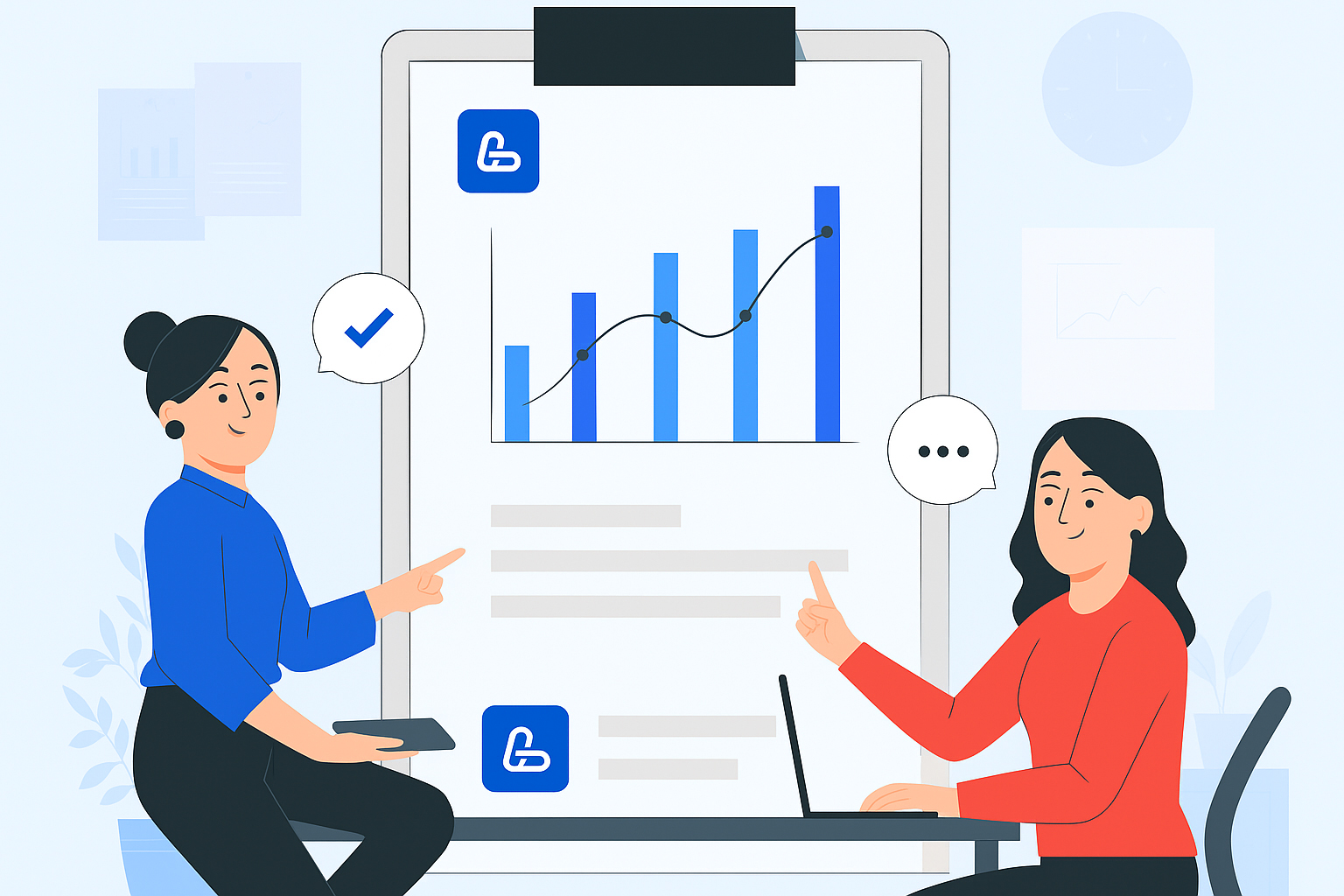
In the rapidly evolving digital landscape, creating and maintaining high-quality referring domains is a crucial component of a successful SEO strategy.
Referring domains serve as a key indicator of authority and trust, as they directly impact your site’s ranking in search engines.
Let’s explore effective methods to increase the number of referring domains, including creating compelling content, collaborating through guest posts, and leveraging infographics and research.
Creating Content That Attracts New Unique Domains
Creating high-quality content is the cornerstone of gaining new referring domains.
The key rule to keep in mind is that your content must be valuable and unique. It’s essential to understand which content formats spark the most interest among users and how they can drive more links.
Here are some popular types of content:
- Educational Articles and Guides
These materials should be packed with practical insights that readers can easily apply. Examples include detailed instructions for solving specific problems or guides on using particular tools. - Comparative Reviews
These help users make informed choices between different products or services. Such articles can attract attention from other sites interested in linking to your authoritative content. - Personal Stories and Case Studies
By focusing on real-world examples, you connect with situations and challenges relevant to your target audience. These materials often build greater trust and, consequently, attract more links.
The success of content creation lies not only in its quality but also in its presentation. By optimizing titles, meta descriptions, and images on your site, you can increase click-through rates and enhance the visibility of your content online.
Guest Posts, PR, and Outreach
Guest posting is a proven method to boost the number of referring domains without waiting for links to appear organically. By publishing articles on external sites, you not only gain high-quality backlinks but also expand your audience reach.
Why does this work?
When you publish a guest post, you typically have the opportunity to include one or two links to your site, either within the article body or in the author bio. This not only improves SEO but also establishes your expertise in your niche.
Where to start:
- Finding Suitable Platforms
Identify sites that publish guest articles related to your topic. One approach is to analyze your competitors’ backlinks to see where they’ve been published and offer similar content. You can also use Google search operators, such as intitle:"guest post" + your niche, to find relevant opportunities manually. - Offering Valuable Content
Approach placements thoughtfully: the higher the quality and value of the content you propose, the better your chances of getting published. The “skyscraper technique” is particularly effective – create content that’s more comprehensive and informative than existing resources, then pitch it to sites as a replacement for outdated links. - Direct Outreach
Don’t hesitate to contact site owners directly. Even if a site doesn’t explicitly state it accepts guest posts, a compelling pitch with relevant content can spark interest. This approach works exceptionally well if you offer material that complements or enhances their existing articles.
What about PR?
Publications in media outlets, mentions in news resources, and interviews with experts in your niche are also powerful sources of referring domains. These links typically originate from authoritative platforms and significantly enhance your site’s overall SEO value.
Using Infographics, Surveys, and Research
Infographics and research are two distinct but equally effective ways to increase referring domains.
Infographics help visualize complex information, making it more digestible and appealing to audiences. This type of content is often more shareable than plain text and is more likely to be cited and linked to by other sites.
Surveys and research, on the other hand, allow you to gather unique data that holds value for other resources. Conducting a survey among your target audience and presenting the results, along with analysis and insights, can attract attention from industry media and blogs. Such publications are frequently cited, especially if they contain fresh, original data relevant to your niche.
How to Increase the Total Number of Backlinks

Backlinks are a critical SEO factor, directly impacting your site’s visibility and authority. The more high-quality links point to your resource, the better its chances of securing top search engine results positions. Below are effective and proven methods to boost their number.
- Publishing on External Platforms
Guest posts remain one of the most reliable strategies for increasing visibility and credibility. By creating valuable content for authoritative sites in your niche, you can embed links to your resource, effectively promoting it. Choose platforms with a relevant audience and a strong reputation. Additionally, contributing to industry blogs, online magazines, and news outlets helps expand reach and increase links simultaneously. - Creating Shareable Content
Produce valuable materials, such as research, guides, or infographics. Such content naturally encourages backlink growth if it solves problems, provides unique data, or is visually appealing. This is particularly effective when sharing survey results or analytics that are hard to find elsewhere. - Engaging with Communities
Participating in discussions on forums, comment sections, specialized chats, or social media offers opportunities to mention your site, especially when done organically and in a relevant manner. These links perform best when embedded in the context of solving a problem, rather than being overtly promotional of your resource. - Leveraging Newsjacking and Collaborations
Become a source of data or expert opinions for industry media. Commenting on trending topics, participating in webinars, and collaborating with other experts helps build your link profile and enhance your reputation. - Monitoring and Reclaiming Mentions
Track where and how your brand is mentioned. If you’re cited without a link, politely request one. This simple tactic can lead to a steady increase in quality backlinks. - Analyzing Competitors
Study your competitors’ link profiles using tools like Ahrefs, Semrush, or Moz. This helps identify valuable platforms that could potentially link to your site as well.
Conclusion: All About Backlinks and Referring Domains
Acquiring high-quality backlinks is a crucial component of any effective SEO strategy.
We’ve discussed numerous methods to help you increase the total number of backlinks, with a focus on creating quality content, guest blogging, and other strategies.
It’s important to remember that backlinks and referring domains are two distinct concepts, yet both are equally vital to your SEO strategy. Backlinks represent the number of links pointing to your site, while referring domains indicate the number of unique domains that link to your pages. Understanding and leveraging these metrics is crucial for achieving long-term success for your website.
Utilize the outlined strategies to boost your site’s visibility and improve your search rankings. The more consistently you enhance the quality of your backlinks, the more resilient your business will become in the future.
Remember, persistent effort and patience will yield results.
How LinkBuilder.com Can Boost Your SEO Strategy
At LinkBuilder.com, we take a comprehensive approach to building link profiles, leveraging both referring domains and backlinks to maximize the impact of your SEO strategy.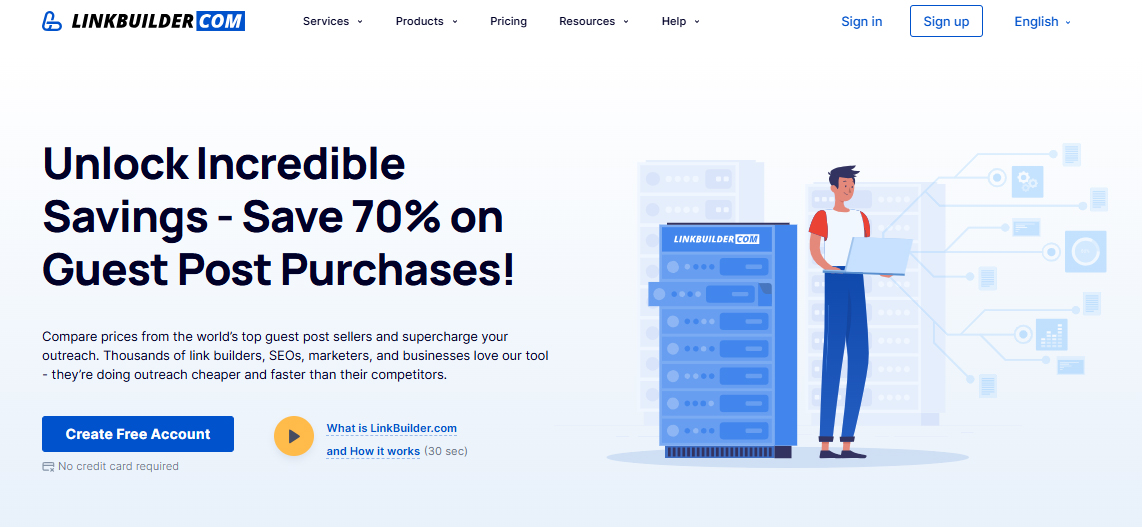
Our team analyzes the competitive landscape, identifies the best link-building opportunities, and crafts a tailored promotion strategy for each client. We don’t just focus on increasing the number of links – we prioritize their quality, topical relevance, and diversity of sources. This approach strengthens your site’s authority, improves search rankings, and drives targeted traffic.
We work with trusted platforms, create shareable content, and foster organic growth in referring domains to ensure every link delivers real value to your business.
If you’re aiming for sustainable and measurable SEO results, trust the link-building experts at LinkBuilder.com.








